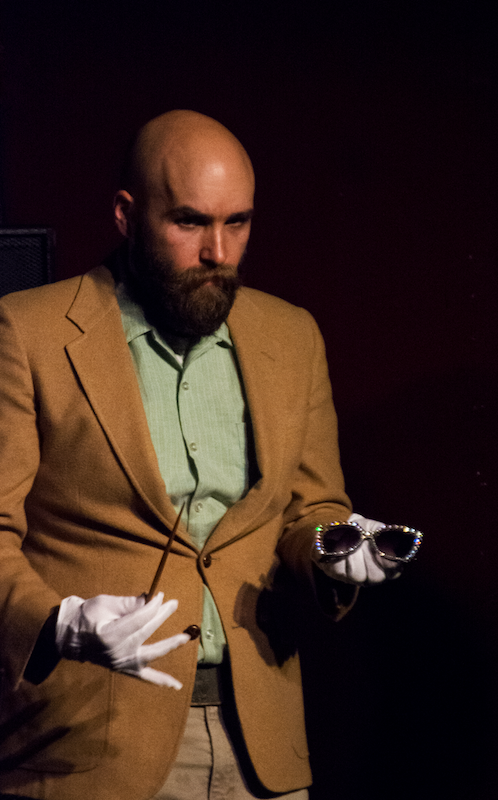Antiques Improv: "Discovering Seattle’s Hidden Treasures!"
Review of Antiques Improv Show at Jet City Improv.
Written by Teen Editor Joshua Fernandes and edited by Teen Editor Olivia Sun.

Money may very well be the root of all evil, but at Antiques Improv Show by Jet City Improv, monetary value becomes the butt of an evening-spanning joke. If you’ve ever found yourself channel-surfing a TV without cable from the hours of 7 to 9 pm, then you’ve likely stumbled upon the incredibly mundane world of Antiques Roadshow. For those who haven’t been enlightened, the basic premise of the show is that local people bring in valuable, old, or innocuous items for appraisal by the traveling Antiques Roadshow experts, and the most valuable or interesting items get put into the show.
Similarly, in Antiques Improv Show, each audience member is encouraged to bring an item of their own for appraisal. Unlike the TV show, however, these items don’t need to be valuable, significant, or even antiques. Instead, it’s up to the “appraisers” (Taya K. Beattie, Glen Dodge, Matt Jurasek, Randy S. Miller, Austin Olson, Jenn Petti, Sam Riordan, and Emily Shuel) to give them value by creating lavish stories for the items. I brought a chess participation trophy I “won” 7 years ago, but after an initial appraisal, it turned out to be a relic from the knights of templar with connections to the holy grail.
The structure of the show goes something like this: 30 minutes before the show, the improvisers mingle with the audience and perform initial appraisals. If an item is interesting enough, it’ll be photographed for use later in the show. Once the show starts, every improviser presents one of these items to the audience, along with the background they’ve “researched” for it. Then, the whole cast performs an improv sketch based on that story.

The first item consisted of two screws suspended in acrylic intended to be used to demonstrate “parallax” at the audience member’s work. But as the appraiser informed us, they turned out to actually be “devil bolts” intentionally kept separate to stop them from touching and causing disaster, as they did on a pirate ship hundreds of years ago. This led into a skit about how the crew members were forced to use these bolts to repair the bow and stern of the boat. All would have been good, but an opposing pirate’s desire to see the two ends of the boat meet caused disaster.
Another person brought up a vinyl figure of Groot from Guardians of the Galaxy. Or so we thought. It was actually a wooden totem honoring “Tuuut”, an esteemed figure in Norse mythology. It was said that the Vikings created these totems using spare wood and sold them to make money on the side. This led into a heart-warming story about how one Viking sought to break away from violence and become a woodcarver full-time, despite the wishes of his wife. It ended with the whole family riding into the sunset on a giant “Tuuut.”
But at the end of the day, all these priceless artifacts still needed a price. Take one audience member’s original painting. The appraiser was quickly brought to tears due to the fact that a specific color on the painting did not actually exist: the quickly dubbed “Shangreen.” This spiraled into a story which ended with Bob Ross painting a couple Shangreen on their wedding day while Bob Ross’ squirrel acted as the ringbearer. The final appraised value of the painting? $10 to $15.

It was all in good fun, and the owner of the most expensive item—a dish from the progressive medieval queendom of Phoon valued at around $2000—won a free ticket for another show at Jet City Improv.
The concept of transforming the exhaustively boring Antiques Roadshow—a show which you’d probably only watch at your grandparents house when you’re too afraid to change the channel—into something worth seeking out is inherently impressive. But in addition to that, the manner in which director Kris Corbitt has chosen to lampoon this incredibly niche culture of old-things enthusiasts simultaneously manages to be dumb fun while also making an incredibly clever analysis of value, history, and knowledge in our modern society. On the lighthearted end of it, I enjoy laughing at six grown adults debate the social consequences of pooping in the living room. But the show also demonstrates the intangibility of knowledge, and the folly of valuing objects based on an invisible history accessible only to the elite. The show really appeals to all demographics. Even if your item doesn’t get picked for the proper show, just getting to interact with the improvisers and hear them give initial appraisals is enough reason to dig through the cardboard boxes in the attic and finally bust out that odd dishware of dubious origin.
Lead photo credit: Duncan Macdonald
The TeenTix Newsroom is a group of teen writers led by the Teen Editorial Staff. For each review, Newsroom writers work individually with a teen editor to polish their writing for publication. The Teen Editorial Staff is made up of 6 teens who curate the review portion of the TeenTix blog. More information about the Teen Editorial Staff can be found HERE.
The TeenTix Press Corps promotes critical thinking, communication, and information literacy through criticism and journalism practice for teens. For more information about the Press Corps program see HERE.

